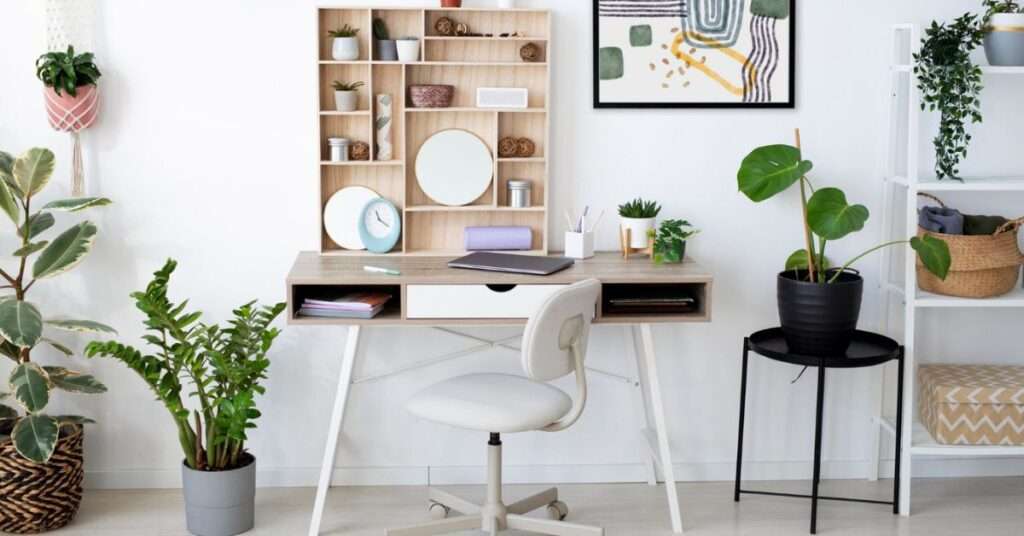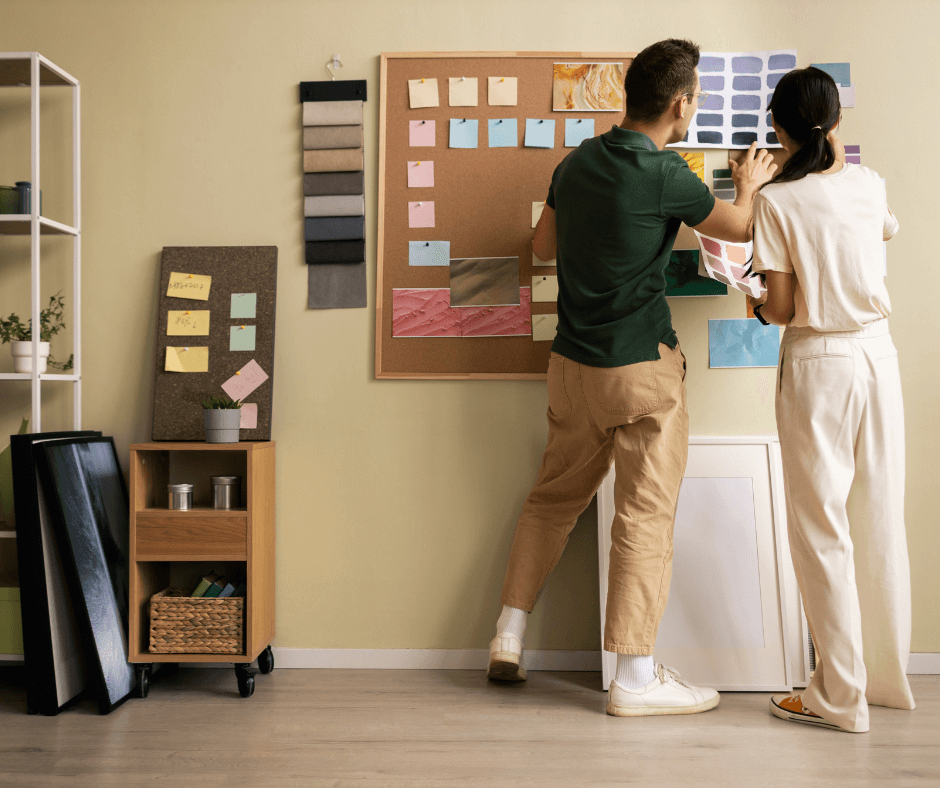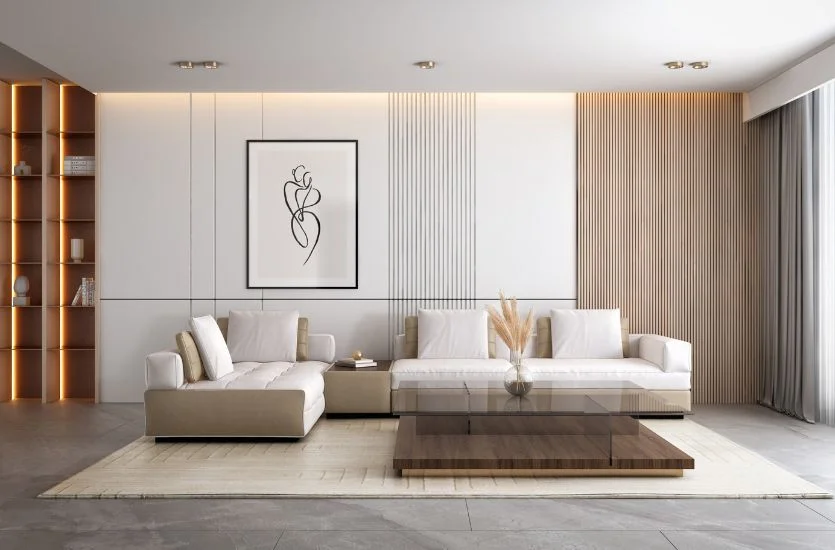When it comes to interior design and renovations, finding the right balance between aesthetics and functionality is key.
Also Read
A well-planned renovation can transform a home, increasing both its value and the comfort it provides. Whether you’re embarking on a full-scale renovation or making minor upgrades, choosing the right interior design style that complements your home’s architecture is crucial.
Additionally, sticking to a budget and planning your renovation carefully will help avoid unnecessary expenses and ensure a smooth process.
In this guide, we will explore everything you need to know about interior design and renovations. From selecting the perfect design style to budgeting for home renovations, we’ll cover it all. We’ll also provide room-by-room renovation tips, sustainable ideas, and how to avoid common renovation mistakes.
Our goal is to help you create a home that reflects your personal style while enhancing its value and functionality. Interior Design and Renovations.
1. How to Choose an Interior Design Style
Choosing the right interior design style is one of the most important decisions when starting any renovation project. Your design style sets the tone for your home, reflecting your personal taste and enhancing the overall aesthetic appeal.

Whether you prefer a minimalist approach or a more eclectic, vibrant look, finding a style that aligns with your vision and your home’s architecture is crucial.
The style you choose also influences other aspects of your renovation, such as furniture selection, color palette, and layout.
Understanding Popular Interior Design Styles
Several interior design styles have become popular due to their versatility and appeal. Let’s explore some of the most common ones:
- Modern: Known for clean lines, neutral color schemes, and minimal decor, modern design emphasizes simplicity and functionality. It works best in open, airy spaces where natural light is abundant. Modern homes often feature sleek materials such as glass, steel, and polished wood.
- Rustic: Rustic design brings warmth and charm through the use of natural materials like wood, stone, and leather. This style often incorporates earthy tones, cozy textiles, and distressed finishes, making it ideal for homes that have a more traditional or country aesthetic.
- Industrial: Inspired by urban lofts and warehouses, industrial design focuses on raw, unfinished materials such as exposed brick, metal beams, and concrete floors. This style is perfect for those who appreciate a more rugged, urban aesthetic.
- Bohemian: For those who love bold colors, eclectic patterns, and layered textures, bohemian style offers a vibrant, carefree approach to interior design. This style embraces individuality and creativity, allowing you to mix and match furniture, decor, and accessories from different cultures and eras.
| Interior Design Style | Key Characteristics |
|---|---|
| Modern | Minimalist, clean lines, neutral color palette |
| Rustic | Natural materials, warm tones, cozy feel |
| Industrial | Exposed materials, urban, rugged aesthetics |
| Bohemian | Eclectic, colorful, mix of patterns and textures |
How to Choose the Best Style for Your Home
When selecting a design style, consider both your personal preferences and your home’s architecture. For example, if your home has large windows and an open layout, a modern interior design may work well, emphasizing the clean lines and open spaces.
Alternatively, if your home has traditional features like wooden beams or a brick fireplace, a rustic style can enhance the natural charm of the space.
Another important factor to consider is how each room’s purpose aligns with the chosen design style. For instance, a modern kitchen with sleek cabinetry and stainless steel appliances pairs well with an open-plan layout.
Meanwhile, a bohemian-style living room can create a warm, inviting space with rich textiles, layered rugs, and cozy seating.
Mixing and Matching Design Styles
It’s common for homeowners to have more than one favorite design style. If you’re drawn to multiple styles, don’t be afraid to mix them. The key to successfully combining styles is to create balance and cohesion by sticking to a unified color palette or incorporating materials that bridge the gap between different aesthetics.
For example, you can blend modern and rustic styles by choosing sleek furniture with wooden accents, or you can mix industrial and bohemian styles by pairing exposed brick walls with colorful, patterned textiles.
When mixing styles, it’s important to let one style dominate and use the other as an accent to avoid a cluttered or disjointed look.
| Blended Style | How to Achieve It |
|---|---|
| Modern + Rustic | Sleek furniture with natural wood accents |
| Industrial + Bohemian | Exposed brick walls with vibrant, layered textiles |
How to Stay Consistent Throughout Your Home
One of the most challenging aspects of interior design is maintaining consistency throughout the home, especially if you’re mixing and matching styles. A consistent color scheme is a great way to unify different design elements.
For instance, if you’ve chosen neutral tones for your modern living room, consider extending similar hues to the bedroom or kitchen to create a cohesive look.
Additionally, using similar materials throughout your home-such as wood, metal, or stone-can help maintain a sense of flow between spaces. While each room can have its own distinct personality, these common elements ensure that your home feels unified and well-designed.

Practical Tips for Choosing the Right Style
- Consider your lifestyle: If you have children or pets, choose materials that are durable and easy to clean. For example, leather furniture and washable rugs are great for high-traffic areas.
- Start small: If you’re unsure about committing to a particular style, start by renovating one room and see how you feel about the look and feel. This way, you can test the waters without overhauling your entire home.
- Consult a designer: If you’re having trouble choosing a style or need help visualizing how different elements will work together, consider hiring an interior designer for guidance.
2. Renovation Planning and Budgeting Tips
Planning a home renovation requires not only creativity but also strategic thinking to ensure that your project stays on budget while delivering maximum value. Whether you’re giving your living room a makeover or tackling a full-scale kitchen renovation, creating a clear plan and managing your finances effectively is crucial.
Without proper budgeting and planning, renovation projects can quickly spiral out of control, leading to unexpected expenses and delays. In this section, we’ll explore how to create a renovation plan, prioritize tasks, and keep your budget in check.
How to Plan a Home Renovation on a Budget
Before starting any renovation, the first step is to develop a detailed renovation plan. This involves listing all the tasks that need to be completed and assigning a budget to each one.
By breaking down your renovation into smaller tasks, you can easily keep track of where your money is going and avoid overspending. Here’s how to start:
- Assess the current state of your home: Walk through each room and make a list of what needs to be updated or repaired. This could include things like replacing old flooring, upgrading appliances, or repainting walls.
- Prioritize tasks: Not all renovations need to be done at once. Start by prioritizing the most essential upgrades—such as fixing structural issues, upgrading the kitchen or bathroom, or installing energy-efficient appliances. Tasks like updating decor or adding luxury finishes can be tackled later if your budget allows.
- Set a budget for each task: Research the cost of materials and labor for each renovation task. This will help you allocate your budget effectively. For example, if you’re renovating a small bathroom, you’ll need to budget for new tiles, fixtures, and possibly plumbing work. Always leave some room in your budget (around 10-15%) for unexpected expenses.
| Renovation Task | Estimated Cost |
|---|---|
| Kitchen Remodel | $10,000 – $25,000 |
| Bathroom Upgrade | $5,000 – $15,000 |
| Living Room Makeover | $2,000 – $8,000 |
| Flooring Replacement | $3 – $10 per square foot |
- Get multiple quotes: When hiring contractors, it’s a good idea to get at least three quotes for each job. This allows you to compare prices and ensure you’re getting the best value for your money.
- Don’t automatically choose the cheapest option-look for contractors who offer a balance between cost, experience, and quality of work.
How to Stick to Your Budget
Staying on budget during a renovation can be challenging, especially when unexpected issues arise. Here are some tips to help you stay on track:
- Avoid last-minute changes: Once you’ve finalized your renovation plan, try to stick to it. Making changes midway through the project can lead to additional costs for materials and labor.
- DIY where possible: For certain tasks, such as painting walls or installing shelves, you can save money by doing the work yourself. Just make sure you’re comfortable with the task before attempting any DIY projects, especially when it comes to more complex work like electrical or plumbing installations.
- Reuse and repurpose: Instead of buying all-new materials, consider repurposing items you already own. For example, you can repaint cabinets rather than replacing them, or refinish hardwood floors instead of installing new ones.
| Money-Saving Tip | Benefits |
|---|---|
| DIY projects | Reduces labor costs, gives you creative control |
| Reuse materials | Saves money and reduces waste |
| Stick to your plan | Avoids unnecessary expenses |
Prioritizing High-Impact Renovations
To get the most value out of your renovation, focus on high-impact areas that provide the best return on investment (ROI).
These areas not only improve the functionality of your home but also add significant value to the property, making it more appealing to future buyers.
- Kitchen Remodel: The kitchen is often considered the heart of the home, and updating this space can significantly boost your home’s value. Key upgrades include installing energy-efficient appliances, replacing countertops, and modernizing the layout with open-plan designs.
- Bathroom Renovation: Upgrading an outdated bathroom is another renovation that offers high ROI. Focus on adding modern fixtures, energy-efficient lighting, and storage solutions. Adding a walk-in shower or a double vanity can also increase the appeal of your bathroom.
- Energy-Efficient Upgrades: Investing in energy-efficient appliances, windows, and insulation can lower your utility bills while making your home more sustainable. Features like smart thermostats and LED lighting not only save energy but also appeal to eco-conscious buyers.
| Renovation Area | ROI (Return on Investment) |
|---|---|
| Kitchen Remodel | 60-80% |
| Bathroom Renovation | 60-70% |
| Energy-Efficient Upgrades | 50-75% |
Budget-Friendly Tips for Small Homes

For those working with smaller spaces, the key to a successful renovation is maximizing functionality while maintaining style. Here are some tips for budget-friendly small home renovations:
- Opt for Multi-Functional Furniture: Choose pieces of furniture that serve more than one purpose, such as a sofa bed or a coffee table with built-in storage. This helps save space while ensuring your home remains practical and stylish.
- Use Light Colors to Open Up Space: Light, neutral colors make small rooms feel larger and brighter. Paint your walls in soft shades of white, beige, or light gray to create an open and airy feel.
- DIY Smaller Projects: If you’re handy, consider taking on smaller renovation tasks yourself, such as painting walls, installing shelves, or refinishing furniture. These simple DIY projects can help you save on labor costs while personalizing your home.
| Small Home Renovation Tip | How It Helps |
|---|---|
| Multi-functional furniture | Maximizes space and functionality |
| Light color schemes | Creates the illusion of a larger room |
| DIY projects | Reduces costs, allows for personal touches |
How to Avoid Common Renovation Mistakes
Many homeowners make the mistake of underestimating the costs and timelines involved in renovation projects. To avoid this, always do thorough research and plan for contingencies. Here’s how:
- Underestimate costs: Always budget for unexpected expenses. Hidden issues like plumbing or electrical problems can emerge during a renovation, so setting aside extra funds is essential.
- Rush the planning phase: Taking the time to plan every detail of your renovation will save you from costly mistakes down the line. Rushing through the planning process often leads to poor design choices and costly changes mid-project.
- Neglect permits and regulations: If your renovation involves structural changes or major upgrades, you may need permits. Check with local authorities to ensure your project meets all regulations.
3. Room-by-Room Renovation Guide
Renovating your home room by room is an effective way to tackle a large project without feeling overwhelmed. Each room serves a unique purpose, and your renovation efforts should reflect that.
Whether you’re updating your living room, kitchen, bathroom, or bedrooms, each space offers the opportunity to improve both aesthetics and functionality.
In this guide, we will explore renovation tips for each room to help you maximize both the value and comfort of your home.
Living Room Renovation Ideas
The living room is often the heart of the home-a place where families gather, entertain guests, and relax. Renovating this space should focus on enhancing comfort and functionality while maintaining a stylish, cohesive design. Here are a few tips to transform your living room:
- Update the Lighting: Lighting plays a crucial role in setting the ambiance of the living room. Consider adding layered lighting, which includes ambient, task, and accent lighting. Smart lighting systems allow you to control brightness and color tones with your smartphone or voice commands, creating a flexible environment.
- Maximize Space with Multi-Functional Furniture: In smaller living rooms, opt for multi-functional furniture. A coffee table with storage or a sofa bed can help save space while offering additional functionality. Modular furniture is another excellent choice, allowing you to reconfigure the seating arrangement based on your needs.
- Create a Focal Point: Whether it’s a fireplace, a piece of art, or a large window, every living room needs a focal point. Renovating around a central feature can enhance the room’s aesthetic and bring balance to the overall design. If you’re installing a modern entertainment system, consider incorporating it into a custom-built media wall for a sleek, integrated look.
| Living Room Update | Benefit |
|---|---|
| Smart lighting system | Allows customizable ambiance and energy efficiency |
| Multi-functional furniture | Maximizes space and enhances practicality |
| Custom media wall | Streamlined look for entertainment systems |
Kitchen Renovation Tips
The kitchen is one of the most frequently used rooms in the home and a major selling point for potential buyers. A kitchen renovation not only enhances the functionality of your home but can also provide a significant return on investment. Here’s how to get started:
- Maximize Storage Space: Storage is one of the most important elements of a well-designed kitchen. Consider adding custom cabinetry, open shelving, or pantry space to keep your kitchen organized and clutter-free. Pull-out shelves and drawer organizers can also optimize storage in smaller kitchens.
- Upgrade to Energy-Efficient Appliances: One of the most impactful changes you can make during a kitchen renovation is upgrading to energy-efficient appliances. Not only will these appliances lower your utility bills, but they also offer modern features that enhance your cooking experience. Smart refrigerators, for example, can alert you when groceries are running low, while smart ovens allow you to control cooking settings remotely.
- Focus on Countertops and Flooring: Durable and stylish countertops are essential in any kitchen renovation. Materials like quartz and granite are popular choices for their longevity and elegance. When selecting flooring, consider options like tile, hardwood, or luxury vinyl that are easy to clean and maintain.
| Kitchen Renovation Feature | Why It’s Important |
|---|---|
| Custom cabinetry | Maximizes storage and improves kitchen organization |
| Energy-efficient appliances | Reduces energy consumption and modernizes the kitchen |
| Durable countertops | Provides long-lasting surfaces for meal prep |
Bathroom Renovation Essentials
A well-designed bathroom can serve as both a functional space and a relaxing retreat. Whether you’re working with a small guest bathroom or a master ensuite, here are some renovation tips to transform your bathroom into a modern, spa-like space:
- Upgrade Fixtures and Hardware: Replacing outdated faucets, showerheads, and handles can give your bathroom a modern, polished look. Choose finishes like brushed nickel or matte black to add sophistication and style. Additionally, consider installing water-saving fixtures, such as low-flow showerheads and dual-flush toilets, to reduce water consumption.
- Add Storage Solutions: Bathrooms often suffer from a lack of storage space. Adding built-in cabinets, floating shelves, or recessed niches can keep your toiletries organized without taking up valuable floor space. Consider incorporating vanity cabinets with hidden storage to maintain a clean, uncluttered look.
- Create a Spa-Like Atmosphere: For a more luxurious feel, consider adding spa-inspired elements to your bathroom. Features like a walk-in shower, a deep soaking tub, or underfloor heating can turn your bathroom into a relaxing retreat. Installing dimmable lighting or smart mirrors with built-in lighting adds to the ambiance.
| Bathroom Upgrade | Why It’s Beneficial |
|---|---|
| Water-saving fixtures | Reduces water consumption and saves on utility bills |
| Built-in storage | Keeps bathroom organized and clutter-free |
| Spa-like features | Enhances relaxation and comfort |
Bedroom Renovation for Comfort and Style
Bedrooms should be a place of relaxation and rest, but they also offer opportunities for personalization and design creativity. Here are some renovation tips to make your bedroom both functional and stylish:
- Choose a Soothing Color Palette: The color scheme you select for your bedroom can greatly influence the room’s ambiance. Soft, neutral tones like beige, gray, or pale blue create a calm, relaxing environment, while bold accent walls can add a touch of personality.
- Add Built-In Storage: If your bedroom lacks space for bulky wardrobes or dressers, consider adding built-in storage solutions. A custom closet system with shelving, drawers, and hanging rods can maximize storage without taking up valuable floor space.
- Upgrade the Lighting: Proper lighting is essential for creating the right mood in a bedroom. In addition to overhead lighting, consider installing dimmable bedside lamps, pendant lights, or even smart lighting systems that allow you to control brightness and color temperature from your smartphone.
| Bedroom Upgrade | Benefit |
|---|---|
| Built-in storage solutions | Maximizes space and keeps belongings organized |
| Smart lighting system | Customizable lighting for a relaxing ambiance |
| Neutral color palette | Creates a calm and restful atmosphere |
Outdoor Space Renovation
Don’t overlook your outdoor space when renovating. A well-designed outdoor area can expand your living space and provide a comfortable setting for relaxation and entertainment. Here are a few renovation ideas to enhance your garden, patio, or backyard:
- Install a Deck or Patio: Adding a deck or patio provides a versatile space for outdoor dining, lounging, or hosting guests. Choose durable materials like composite decking or natural stone that can withstand various weather conditions.
- Incorporate Greenery: Planting trees, shrubs, or flowers not only beautifies your outdoor space but also provides shade and privacy. For those with limited space, consider vertical gardening options like trellises or hanging planters.
- Add Outdoor Lighting: Outdoor lighting can enhance the beauty and safety of your garden or patio. String lights, pathway lighting, or smart outdoor lighting systems can create a cozy, inviting atmosphere for evening gatherings.
| Outdoor Upgrade | How It Helps |
|---|---|
| Deck or patio installation | Expands outdoor living space |
| Smart outdoor lighting | Improves safety and ambiance |
| Vertical gardening | Maximizes green space in smaller areas |
4. Sustainable and Eco-Friendly Renovation Ideas
As homeowners become more conscious of their environmental impact, sustainable and eco-friendly renovation practices have become increasingly popular. Not only do these renovations help reduce your carbon footprint, but they can also lead to significant long-term savings on energy bills.
Moreover, sustainable homes are attractive to potential buyers who value environmentally responsible living. In this section, we’ll explore some of the best eco-friendly renovation ideas to make your home more energy-efficient, environmentally friendly, and cost-effective.
What Are the Best Sustainable Materials for Renovations?
Choosing sustainable materials for your home renovation is one of the most impactful ways to reduce your environmental footprint. Sustainable materials are often renewable, recycled, or sourced responsibly, and they’re designed to last, reducing the need for frequent replacements.
Here are some eco-friendly materials you can incorporate into your renovation project:
- Bamboo Flooring: Bamboo is one of the most sustainable building materials available. It grows quickly, making it a renewable resource, and it’s durable, providing longevity similar to hardwood flooring. Bamboo flooring is ideal for living rooms, bedrooms, or hallways due to its resilience and aesthetic appeal.
- Recycled Glass Countertops: Made from repurposed glass, these countertops offer an eco-friendly alternative to granite or marble. They’re durable, heat-resistant, and available in a wide range of colors and finishes. Using recycled glass in your kitchen or bathroom reduces waste and adds a unique design element to your home.
- Cork Insulation: Cork is a natural insulator that is harvested from the bark of cork oak trees, which regenerate after each harvest. Cork insulation is a sustainable and effective way to keep your home warm in the winter and cool in the summer, reducing the need for excessive heating or air conditioning.
| Sustainable Material | Why It’s Eco-Friendly |
|---|---|
| Bamboo Flooring | Fast-growing, renewable, and durable |
| Recycled Glass Countertops | Made from repurposed materials, reducing waste |
| Cork Insulation | Renewable, natural insulator |

How to Design an Energy-Efficient Home
Energy efficiency is a key component of sustainable renovations. By making your home more energy-efficient, you can reduce your reliance on fossil fuels and lower your utility bills. Here are a few energy-efficient renovation ideas:
- Install Energy-Efficient Windows: Replacing old, single-pane windows with energy-efficient double or triple-pane windows can dramatically improve your home’s insulation. Energy-efficient windows reduce heat loss in the winter and keep your home cooler in the summer, resulting in lower heating and cooling costs.
- Add Solar Panels: Solar panels are one of the most effective ways to make your home energy-independent. While the upfront costs can be high, solar panels significantly reduce your electricity bills and can eventually pay for themselves. In addition, many states offer tax credits or incentives for homeowners who install solar panels, making it a financially viable option.
- Upgrade to Smart Thermostats: Installing smart thermostats is another energy-saving measure. These devices learn your daily routine and adjust the heating or cooling system accordingly, ensuring that your home uses energy only when needed. With remote control options, you can adjust your home’s temperature from your phone, further enhancing energy efficiency.
| Energy-Efficient Upgrade | Benefit |
|---|---|
| Energy-Efficient Windows | Reduces heating and cooling costs |
| Solar Panels | Lowers electricity bills and energy dependence |
| Smart Thermostats | Optimizes energy use based on daily habits |
Why Eco-Friendly Renovations Increase Home Value
Eco-friendly renovations not only benefit the environment but also enhance your home’s resale value. As more buyers look for homes that incorporate sustainable features, investing in energy-efficient upgrades can make your property more attractive to potential buyers.
Features such as energy-efficient appliances, solar panels, and sustainable materials are increasingly seen as valuable assets in the real estate market.
- Lower Utility Costs: Homes with energy-efficient upgrades-such as energy-saving windows, insulation, or appliances-offer lower utility costs for homeowners. This is a significant selling point, especially as energy prices continue to rise.
- Increased Market Appeal: Sustainable homes appeal to eco-conscious buyers who prioritize green living. Features like solar panels, energy-efficient heating systems, and low-impact building materials can set your home apart from others on the market.
- Longevity of Materials: Sustainable materials like bamboo flooring or recycled glass countertops are not only eco-friendly but also durable. Potential buyers are attracted to materials that offer long-lasting quality and reduced maintenance costs.
| Eco-Friendly Feature | How It Increases Value |
|---|---|
| Energy-Efficient Appliances | Lower utility costs, appealing to buyers |
| Solar Panels | Reduces long-term electricity costs |
| Sustainable Materials | Durable and low-maintenance, adds aesthetic appeal |
Eco-Friendly Water Solutions
Water conservation is an important part of eco-friendly home renovations. Here are some water-saving solutions that can reduce your home’s water consumption while maintaining its functionality:
- Low-Flow Fixtures: Installing low-flow faucets, showerheads, and toilets can significantly reduce water usage without compromising performance. These fixtures are designed to use less water by maintaining water pressure with innovative technology.
- Rainwater Harvesting Systems: Rainwater harvesting involves collecting and storing rainwater for later use in irrigation, toilets, or even laundry. Installing a rainwater collection system reduces reliance on municipal water supplies and provides an eco-friendly source of water for non-potable uses.
- Greywater Recycling: Greywater recycling systems collect water from sinks, showers, and laundry machines, treating it for reuse in toilets or irrigation. This system allows you to reduce water waste and lower your water bill, making it an eco-friendly solution for homeowners.
| Water-Saving Solution | Environmental Benefit |
|---|---|
| Low-Flow Fixtures | Reduces water consumption and waste |
| Rainwater Harvesting | Reduces reliance on municipal water supply |
| Greywater Recycling | Reuses water for non-potable purposes |
5. Choosing the Right Materials and Finishes
Selecting the right materials and finishes for your renovation is critical to ensuring both the aesthetic appeal and durability of your home. With a wide array of options available, it’s important to choose materials that not only complement your interior design style but also stand the test of time.
Additionally, considering sustainable materials that contribute to an eco-friendly home can enhance both your home’s value and your environmental impact.
How to Select Durable and Stylish Materials for Your Renovation
When choosing materials for your renovation, it’s essential to focus on durability, maintenance, and visual appeal. Certain areas of the home, such as the kitchen, bathroom, and flooring, endure more wear and tear, so selecting materials that can withstand heavy use is key.
Here are some tips for selecting the right materials:
- Countertops: In high-traffic areas like the kitchen, countertops must be durable and resistant to heat, stains, and scratches. Quartz and granite are excellent options for countertops as they offer longevity, require little maintenance, and provide an upscale look. Both materials come in a variety of colors and patterns, allowing you to match your interior design style.
- Flooring: The type of flooring you choose should depend on the room’s function. For high-traffic areas such as the living room or kitchen, hardwood, tile, or luxury vinyl are popular choices due to their durability and ease of maintenance. In bedrooms, where comfort is key, carpet or cork flooring can offer a softer, more inviting feel.
- Cabinetry: When selecting cabinetry for the kitchen or bathroom, consider materials like solid wood, plywood, or thermofoil, which offer durability and aesthetic versatility. Solid wood cabinets provide a classic look but require more maintenance, while plywood is a cost-effective alternative that is still durable and stylish.
| Material | Best For |
|---|---|
| Quartz or Granite | Kitchen countertops, durable and heat-resistant |
| Hardwood or Tile Flooring | High-traffic areas like living rooms and kitchens |
| Solid Wood or Plywood | Kitchen cabinetry, long-lasting and versatile |
Sustainable and Cost-Effective Material Choices
If you’re looking for eco-friendly options, several sustainable materials are both durable and stylish. Using renewable or recycled materials reduces your renovation’s environmental impact while still delivering a high-quality finish. Some options include:

- Bamboo Flooring: Bamboo is a renewable material that grows much faster than traditional hardwood. It offers a similar look to hardwood floors, is extremely durable, and is perfect for areas like bedrooms or living rooms.
- Recycled Glass Countertops: Made from recycled glass and concrete, these countertops offer a unique look while reducing waste. They are durable, non-porous, and available in a wide range of colors, making them an eco-friendly alternative to natural stone countertops.
- Cork Flooring: Cork is another renewable resource that provides excellent insulation and soundproofing properties. It’s comfortable underfoot, making it ideal for bedrooms or home offices. Cork is also hypoallergenic and resistant to mold and mildew, which adds to its sustainability credentials.
| Sustainable Material | Why It’s Eco-Friendly |
|---|---|
| Bamboo Flooring | Fast-growing and renewable |
| Recycled Glass Countertops | Reduces waste and offers a unique aesthetic |
| Cork Flooring | Renewable, hypoallergenic, and soundproofing |
What Are the Most Cost-Effective Finishes for Home Renovations?
Choosing cost-effective finishes can help keep your renovation on budget without compromising on style. Here are a few options that offer great value for money:
- Laminate Flooring: Laminate flooring is a budget-friendly alternative to hardwood and is highly durable, making it suitable for high-traffic areas. With advances in technology, laminate flooring can closely mimic the look of natural wood or stone.
- Ceramic Tile: Ideal for bathrooms and kitchens, ceramic tiles are affordable and come in a wide variety of styles, colors, and patterns. They are resistant to moisture, easy to clean, and offer excellent durability, making them a popular choice for these high-use spaces.
- Paint and Wall Finishes: One of the most cost-effective ways to update a room is with a fresh coat of paint. Choose neutral tones for a versatile backdrop or bold accent walls to add a splash of color. Textured wall finishes or wallpapers can also enhance a room’s character without requiring a major investment.
| Cost-Effective Finish | Benefits |
|---|---|
| Laminate Flooring | Durable and budget-friendly |
| Ceramic Tile | Affordable and versatile, ideal for bathrooms |
| Neutral Paint or Wallpaper | Simple way to refresh any room |
Why Material Selection Is Crucial for Long-Term Maintenance
The materials you choose for your renovation not only affect the look and feel of your home but also its long-term maintenance needs. High-quality, durable materials may cost more upfront but often require less maintenance and last longer, saving you money in the long run.
- Hardwood Flooring vs. Laminate: While hardwood floors are more expensive than laminate, they can be refinished multiple times, giving them a lifespan of 30 years or more. Laminate, on the other hand, cannot be refinished but offers a similar appearance at a lower cost and requires less upkeep.
- Countertops: Quartz countertops are more expensive than laminate but are highly resistant to stains, heat, and scratches. They require minimal maintenance and can last a lifetime, making them a worthwhile investment for kitchens and bathrooms.
- Cabinetry: Solid wood cabinetry is a long-lasting choice but requires regular maintenance to prevent warping or cracking. Plywood is a more affordable option that offers durability with lower maintenance requirements.
Choosing materials with durability and longevity in mind ensures that your renovation not only looks great when it’s finished but continues to perform well over time. Opting for low-maintenance materials will save you both time and money in the years to come.
6. Hiring Professionals vs. DIY Renovations
When planning a home renovation, one of the biggest decisions you’ll face is whether to hire a professional or tackle the project yourself. Both approaches have their pros and cons, and the right choice depends on your skills, budget, and the complexity of the renovation.
While some tasks are perfect for a DIY approach, others require the expertise and precision that only professionals can provide. In this section, we’ll explore when it’s best to hire professionals and when a DIY renovation can save you money and add a personal touch.
When Should You Hire a Professional Interior Designer or Contractor?
While it can be tempting to go the DIY route for every part of your renovation, there are some tasks that should be left to the experts. Here are a few instances where hiring a professional is recommended:
- Complex Structural Changes: If your renovation involves major structural changes, such as knocking down walls, adding extensions, or modifying your home’s foundation, it’s essential to hire a professional contractor. These projects require a deep understanding of building codes, permits, and safety regulations, which an experienced contractor can handle.
- Electrical and Plumbing Work: Electrical and plumbing tasks are best left to licensed professionals. Mistakes in these areas can lead to serious safety hazards, such as electrical fires or water damage. For tasks like rewiring, installing new light fixtures, or upgrading plumbing, hiring a professional ensures the work is done safely and up to code.
- Large-Scale Renovations: For extensive renovations involving multiple rooms or major changes to your home’s layout, hiring a contractor or interior designer can help you manage the project more efficiently. Professionals can coordinate between different tradespeople, ensure that the work is done on schedule, and provide valuable input on design choices.
| When to Hire a Professional | Why It’s Important |
|---|---|
| Complex structural changes | Ensures compliance with building codes |
| Electrical and plumbing work | Avoids safety hazards and ensures proper installation |
| Large-scale renovations | Streamlines project management and design |
What Are the Benefits of DIY Renovations?
For homeowners who enjoy working with their hands and want to save money, DIY renovations can be a rewarding option. Not only does DIY allow you to take control of your project, but it also offers opportunities to learn new skills and add personal touches to your home.
Here are some benefits of taking on a DIY renovation:
- Cost Savings: One of the biggest advantages of DIY renovations is the potential to save on labor costs. Hiring professionals can be expensive, especially for smaller tasks like painting or installing shelves. By doing the work yourself, you can stretch your budget further and allocate more funds to materials or larger projects.
- Personalization: DIY projects give you the freedom to customize your home exactly the way you want. Whether it’s building a custom bookshelf, painting accent walls, or designing a unique backsplash for your kitchen, DIY allows you to add personal touches that reflect your style.
- Satisfaction: There’s a sense of pride and accomplishment that comes with completing a renovation project yourself. Tackling a project from start to finish, and seeing the results of your hard work, can be incredibly rewarding.
| DIY Project | Benefits |
|---|---|
| Painting walls or rooms | Cost-effective, easy to do, customizable |
| Installing shelves or cabinetry | Adds storage and personalization |
| Building custom furniture | Creates one-of-a-kind pieces for your home |
Which Renovation Tasks Are Perfect for DIY?
Some renovation tasks are more suited to a DIY approach than others. If you’re comfortable using tools and have a basic understanding of home improvement, here are a few tasks you can confidently tackle on your own:
- Painting: Painting is one of the easiest and most impactful DIY projects. With minimal tools and materials, you can refresh a room with a new coat of paint in just a day or two. Whether you’re updating a neutral color or adding a bold accent wall, painting is a straightforward and affordable way to transform a space.
- Tiling: Installing tiles in the bathroom, kitchen, or entryway is a popular DIY project that can add style and functionality to your home. While tiling requires precision, there are plenty of resources, tutorials, and tools available to guide you through the process.
- Installing Fixtures and Shelves: Simple tasks like hanging shelves, installing light fixtures, or replacing cabinet hardware are perfect for DIY. These projects can be done in a few hours and don’t require specialized skills, making them an easy way to update a room without hiring a contractor.
| DIY Task | Why It’s a Good DIY Project |
|---|---|
| Painting walls | Low-cost, easy to do, and transformative |
| Installing tiles | Adds style and value, requires basic tools |
| Hanging shelves or fixtures | Quick to install, adds functionality |
When DIY Renovations Might Cost You More

While DIY can save money, it’s important to know your limits. Attempting complex projects without the necessary skills or tools can lead to mistakes that are expensive to fix. Here are a few scenarios where DIY might cost more in the long run:
- Incorrect Installation: If you attempt to install plumbing, electrical wiring, or appliances incorrectly, you could end up causing damage that requires costly repairs. For example, a DIY electrical job that goes wrong could result in faulty wiring, electrical fires, or short circuits. Similarly, mistakes in plumbing installation can lead to water leaks or flooding.
- Lack of Experience: Without the right experience, DIY projects can take much longer than expected. This not only delays your renovation but also increases the likelihood of costly mistakes. Inexperienced DIYers might waste materials, make measurement errors, or fail to follow instructions properly, leading to wasted time and money.
- Safety Hazards: Some renovation tasks—such as working with electrical wiring or handling heavy equipment—come with safety risks. Without proper training, you could put yourself or others at risk of injury. For these tasks, it’s safer and more cost-effective to hire a professional who can complete the work safely and efficiently.
| Why DIY Might Cost More | Potential Issues |
|---|---|
| Incorrect installation | Leads to expensive repairs or reinstallation |
| Lack of experience | Causes delays, wasted materials, and mistakes |
| Safety hazards | Risks injury and additional costs |
How to Find the Right Contractor for Your Renovation
When hiring a professional contractor, it’s important to do your research to ensure you’re working with someone experienced, reliable, and trustworthy. Here are a few tips for finding the right contractor for your renovation:
- Check Credentials: Always ensure that your contractor is licensed, insured, and bonded. This protects you in the event of any damage or accidents that occur during the renovation. Ask for proof of their credentials and verify their license through local authorities.
- Read Reviews and Get Recommendations: One of the best ways to find a reliable contractor is through referrals from friends, family, or neighbors. Additionally, read online reviews and ask for references from previous clients to get a sense of their work quality and reliability.
- Get Multiple Quotes: It’s a good idea to get at least three quotes from different contractors. This not only gives you a sense of what the project will cost but also allows you to compare services, timelines, and materials. Don’t automatically go with the cheapest quote—look for contractors who offer value for money and demonstrate professionalism.
| Finding the Right Contractor | What to Look For |
|---|---|
| Check credentials | Verify licenses, insurance, and bonding |
| Read reviews and get recommendations | Ask for references and read testimonials |
| Get multiple quotes | Compare prices, services, and timelines |
7. Interior Design Trends to Watch
As interior design continues to evolve, keeping up with the latest trends can inspire and enhance your home renovation projects. While some trends come and go, others offer timeless appeal that can refresh your living space and add value to your home.
Whether you prefer sleek, minimalist aesthetics or cozy, eclectic vibes, there’s a design trend to suit every style and space. In this section, we’ll explore some of the hottest interior design trends and how you can incorporate them into your home renovation.
1. Biophilic Design: Bringing Nature Indoors
One of the most prominent trends in recent years is biophilic design, which focuses on connecting your home with nature. This trend emphasizes natural materials, organic shapes, and abundant greenery to create a calming, rejuvenating environment.
The goal is to foster a sense of wellness and tranquility by integrating natural elements into your living space.
How to Incorporate Biophilic Design:
- Use natural materials: Incorporate wood, stone, and bamboo into your design through furniture, flooring, and countertops. These materials not only add warmth and texture but also evoke a connection to nature.
- Add greenery: Indoor plants are an essential element of biophilic design. From small succulents on the windowsill to larger potted plants in the living room, greenery can improve air quality and bring life to your home.
- Maximize natural light: Large windows, skylights, and glass doors help bring in more natural light, which is a key component of this design trend. Choose light, airy curtains or opt for window treatments that allow for maximum sunlight.
| Biophilic Design Element | How It Enhances Your Home |
|---|---|
| Natural materials (wood, stone) | Adds warmth, texture, and an organic feel |
| Indoor plants | Improves air quality, brings nature indoors |
| Large windows/skylights | Increases natural light and promotes wellness |
2. Minimalism with a Cozy Twist (Soft Minimalism)
Minimalism has long been a popular design trend, but soft minimalism adds a new dimension by blending simplicity with warmth and comfort.
This trend retains the clean lines and uncluttered spaces of traditional minimalism but introduces soft textures, warm neutral colors, and cozy furnishings for a more inviting feel.
How to Achieve Soft Minimalism:
- Neutral color palette: Stick to soft, warm tones like beige, cream, and muted grays. These colors create a serene, peaceful environment while still maintaining the sleek look of minimalism.
- Textured fabrics: To prevent your space from feeling cold or sterile, incorporate plush fabrics like wool, linen, or cotton. Cozy throws, soft rugs, and textured cushions can soften the minimal aesthetic.
- Functional yet comfortable furniture: Choose furniture that serves a purpose without sacrificing comfort. Opt for clean-lined sofas, chairs, and tables that blend function with warmth.
| Soft Minimalism Feature | Why It’s Popular |
|---|---|
| Neutral, warm tones | Creates a serene and peaceful atmosphere |
| Cozy textures (wool, linen) | Adds warmth and comfort to minimal spaces |
| Functional, comfortable furniture | Blends practicality with coziness |
3. Multi-Functional Spaces
As homes adapt to modern lifestyles, there’s an increasing demand for multi-functional spaces that can serve several purposes. Whether it’s a home office that doubles as a guest room or a kitchen that extends into a living area, designing spaces that offer flexibility is becoming a top trend.
How to Create Multi-Functional Spaces:
- Modular furniture: Opt for furniture that can be rearranged or repurposed. For instance, a fold-out sofa can turn a living room into a guest bedroom, while a modular desk system allows for quick changes from workspace to leisure area.
- Open-plan layouts: Consider removing walls between your kitchen, dining, and living areas to create a more versatile space. Open-plan layouts offer flexibility and make smaller homes feel more spacious.
- Hidden storage solutions: Use smart storage ideas to keep multi-functional rooms organized. For example, built-in shelving, under-bed storage, or storage ottomans can help you manage clutter and make the most of limited space.
| Multi-Functional Element | How It Enhances Functionality |
|---|---|
| Modular furniture | Easily transforms spaces for different uses |
| Open-plan layout | Maximizes space, ideal for entertaining |
| Hidden storage solutions | Keeps clutter at bay, improves space utility |
4. Earth Tones and Natural Colors
In line with the biophilic trend, earth tones and natural colors have gained popularity as they evoke warmth and comfort while connecting the interior environment to the natural world.
These shades include muted greens, soft browns, terracotta, beige, and rich neutrals, all of which help create a soothing, grounding atmosphere in the home.
How to Use Earth Tones in Your Interior Design:
- Wall colors: Paint your walls in warm earth tones like olive green, clay, or taupe. These colors provide a neutral backdrop while making the space feel cozy and inviting.
- Accent pieces: Incorporate natural colors through furniture, decor, and textiles. A terracotta throw pillow, a beige rug, or a clay vase can introduce these shades subtly into your home.
- Natural materials: Complement earth tones with natural materials like wood, rattan, or stone. These materials work beautifully with neutral color schemes and add texture and warmth.
| Earth Tone Color | Why It Works |
|---|---|
| Olive green or taupe walls | Creates a neutral yet cozy backdrop |
| Terracotta or clay accents | Adds warmth and a pop of natural color |
| Natural materials (wood, stone) | Complements earthy shades, adds texture |
5. Bold Accent Walls and Artistic Expression
While neutral tones remain popular, there’s a growing trend of using bold accent walls and artistic elements to add visual interest and personality to a room. From vibrant paint colors to mural-style wallpaper, accent walls can serve as the focal point of a space and express your unique style.
How to Incorporate Bold Accent Walls:
- Paint an accent wall: Choose a bold, contrasting color like navy blue, forest green, or deep burgundy for one wall in your living room or bedroom. This creates a striking focal point that draws the eye.
- Use patterned wallpaper: Mural-style wallpaper or geometric patterns can transform an ordinary room into a work of art. Consider using wallpaper on one wall or in a small space like a hallway or powder room for dramatic effect.
- Artistic details: Combine your accent wall with artistic touches, such as framed artwork, tapestries, or hanging sculptures. This enhances the overall look and allows you to express your creativity.
| Accent Wall Element | Why It Stands Out |
|---|---|
| Bold paint colors | Adds drama and focal interest |
| Patterned wallpaper | Transforms a room with visual texture |
| Artistic accessories | Personalizes the space with unique touches |
6. Smart Home Integration with a Design Focus
With the rise of technology, smart home devices have become integral to modern living. However, the latest trend goes beyond functionality-smart home integration now emphasizes aesthetics as well. The focus is on incorporating smart technology seamlessly into your home’s design without compromising on style.
How to Integrate Smart Home Technology with Design:
- Smart lighting: Smart lighting systems offer both practicality and ambiance. You can control the brightness, color, and scheduling of lights via voice command or smartphone. Look for smart lighting options with sleek designs that blend seamlessly with your interior.
- Hidden smart devices: To maintain a clean, uncluttered look, choose devices that can be built into furniture or hidden. For example, hide speakers in custom shelving or incorporate smart thermostats into the design of your walls.
- Stylish smart appliances: Modern smart appliances like refrigerators, ovens, and washers now come in a variety of sleek finishes, including stainless steel and matte black, allowing you to maintain a cohesive, modern look.
| Smart Home Device | How It Fits Your Design |
|---|---|
| Smart lighting | Customizes ambiance while blending into decor |
| Hidden smart speakers | Maintains a clean, uncluttered aesthetic |
| Stylish smart appliances | Enhances kitchen functionality with modern finishes |
Conclusion on Interior Design and Renovations
Interior design and renovations offer endless possibilities for transforming your home into a functional, stylish, and comfortable living space.
By carefully selecting an interior design style, setting a realistic budget, and incorporating the latest trends, you can create a home that reflects your personality while enhancing its value.
From eco-friendly renovation ideas to multi-functional spaces and smart home integration, today’s renovation projects can go beyond aesthetics, improving both the efficiency and sustainability of your home.
Whether you decide to hire professionals for complex tasks or take a DIY approach for smaller projects, planning is key to achieving the best results. Additionally, staying up-to-date with current design trends, such as biophilic design or soft minimalism, can keep your home fresh and modern.
Ultimately, a well-executed renovation should provide long-term value, blending style, functionality, and sustainability. By incorporating durable materials, energy-efficient upgrades, and timeless design choices, your renovation will stand the test of time, making your home a place you can enjoy for years to come.
FAQ about Interior Design and Renovations
1. What is the most cost-effective way to renovate a small home?
Focus on multi-functional spaces, neutral color schemes, and DIY projects like painting or installing shelves. Additionally, invest in smart storage solutions to maximize space without breaking the bank.
2. How can I choose the right interior design style for my home?
Start by assessing your personal preferences and how they align with your home’s architecture. You can explore popular styles like modern, rustic, or bohemian, or mix and match styles to create a unique, cohesive look.
3. Are eco-friendly renovations worth the investment?
Yes, eco-friendly renovations like energy-efficient windows, smart thermostats, and sustainable materials not only reduce your carbon footprint but also lower utility costs and increase your home’s resale value.
4. Should I hire a professional or go the DIY route for my renovation?
For complex tasks like electrical work or structural changes, it’s best to hire professionals. However, DIY is great for smaller projects such as painting, tiling, or installing fixtures to save on labor costs.
5. What are some trends to watch in interior design?
Popular trends include biophilic design, which incorporates natural elements into your home, and soft minimalism, which blends simplicity with warmth. Multi-functional spaces and smart home integration are also key trends for modern living.





Üsküdar su tesisatı hizmeti Rothenberger cihazı ile su kaçağını bulduklarında Üsküdar’daki evimde hiçbir yer zarar görmedi, çok başarılıydılar. https://uptoscreen.com/read-blog/32406
Keep up the fantastic work! Kalorifer Sobası odun, kömür, pelet gibi yakıtlarla çalışan ve ısıtma işlevi gören bir soba türüdür. Kalorifer Sobası içindeki yakıtın yanmasıyla oluşan ısıyı doğrudan çevresine yayar ve aynı zamanda suyun ısınmasını sağlar.
Excellent post. I was checking continuously this blog and I am impressed! Extremely helpful info specially the last part 🙂 I care for such info a lot. I was looking for this particular info for a very long time. Thank you and best of luck.